#basically: his deafness was treated v inconsistently the first time
Text
mentions of 616 hawkeye’s deafness prior to 2014
see here for my simplified timeline of 616 clint barton’s deafness
clint barton debuted in 1964 as a hearing character. in the last issue of his first solo series, hawkeye vol. 1 #4 (released in december 1983), clint became hard of hearing when he activated his hypersonic arrowhead in his mouth to drown out a mind-control frequency:
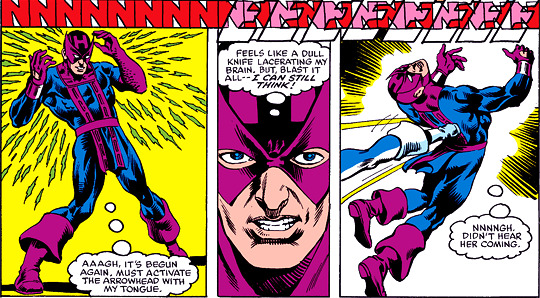
clint’s subsequent official marvel handbook entries would note that he was 80% deaf in both ears:

he would remain so up until either 1996 or the end of 1997, after which he was hearing once again (we’ll get to his re-deafening in 2014 later). the following panels will focus on the 1984-1996 period.
clint returned to the avengers after the events of his solo series in avengers #239 (1984), wherein he informed the team of his hearing loss and was given a hearing aid (which he chooses not to wear in the issue because he’s appearing on tv):

he informs cap, who wasn’t present in #239, of his hearing loss (and elopement) in avengers #241 (1984):

his hearing loss isn’t brought up again until over a year later in west coast avengers v2 #1 (1985):
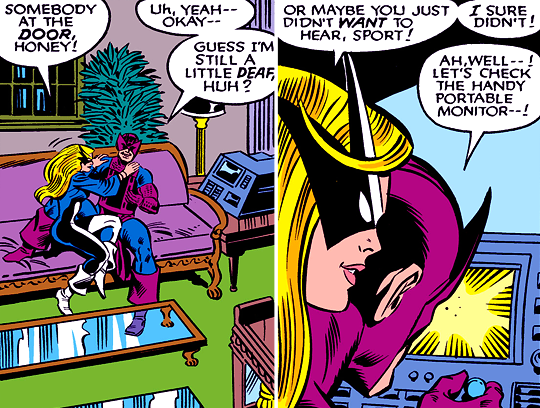
he first mentions that he’s wearing a hearing aid in captain america #317 (1986). this issue was written by mark gruenwald, who also wrote hawkeye v1 where clint was deafened, so he was in a good position to call back to it and remind the reader of this development:

all further acknowledgment of clint’s hearing loss in this period occurred in one series: solo avengers (later renamed to avengers: spotlight). it’s interesting to note that in all but one of these instances, clint is written as either turning down his hearing aid to avoid sound-based attacks, or “turning it up” to hear extraordinarily quiet noises.
the first instance is in solo avengers #9 (1988):

solo avengers #10 (1988) establishes in-comic that clint is 80% deaf in both ears, a specificity which had only previously been mentioned in his marvel handbook entries:

one i initially forgot: in west coast avengers #40 (1988), clint turns up his hearing aid to hear the shroud’s movement in pitch darkness
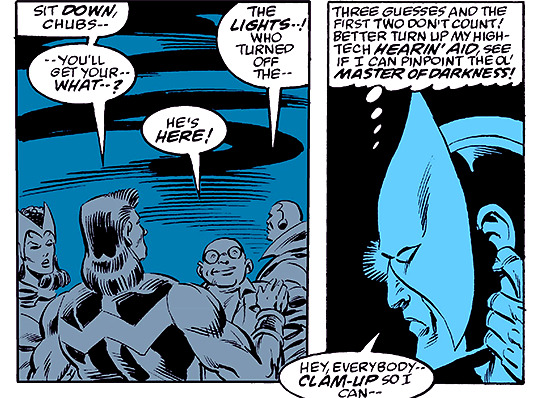
solo avengers #16 (1989) has clint hearing something that would be undetectable by an average hearing person. notably, this is also the only panel i’ve seen from 1984-1996 where clint visibly has a hearing aid. although as you can see, the coloring places it outside of his mask (half the time clint’s mask is portrayed as covering his ears and half not because of coloring):

here’s a sound attack dodge in solo avengers #17 (1989):

in avengers: spotlight #26 (1989), clint disables high-tech devices, and is shown not to hear tony speaking to him once his hearing aid is turned off in the last page:
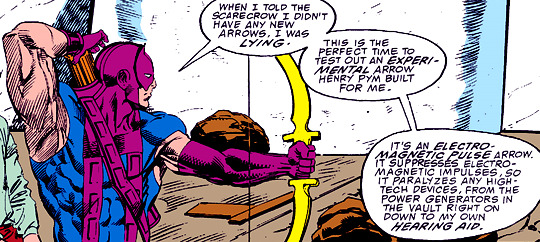
in avengers: spotlight #28 (1990), clint is immune to the combined sound powers of the issue’s villains--where others perceived a visual illusion of them as other people, clint saw them in their true forms:
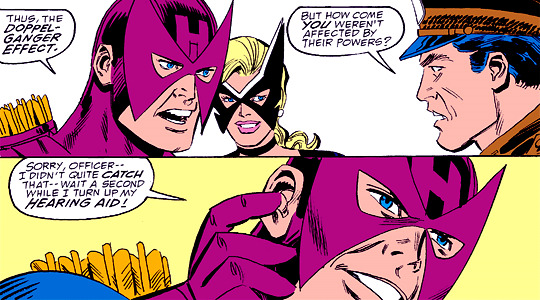
from what i’ve observed, there were no mentions of hearing loss or appearances of hearing aids from 1991-1996. so to tally these up, 6/11 of all mentions after hawkeye v1 #4 were from the same series.
in 1996, clint was killed in marvel’s onslaught event (along with most marvel heroes). he then appeared in marvel’s briefly rebooted universe, counter-earth (created by young franklin richards and accessible through his toy ball. yeah.). whether counter-earth hawkeye is considered the same person as 616 clint is a whole can of comic worms we’ll not worry ourselves with...
he did appear without a mask on counter-earth in avengers v2 #11 (1997). honestly, with how it’s drawn, i can’t entirely tell if it’s meant to be a hearing aid, some take on a futuristic hospital monitor, or what. in any case:

in 1998, clint is revived/returned, and is no longer deaf. an in-universe explanation for why is given in avengers annual v3 2001:
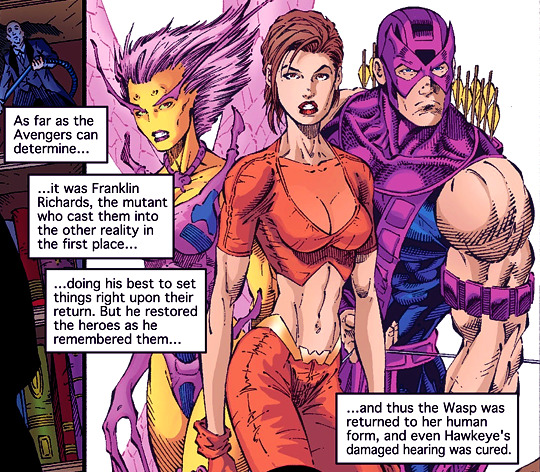
the editorial reason given for the change is that clint’s hearing loss was treated very inconsistently in-comics, and by ‘98, was largely not known among both writers and readers. this seems plausible; unless they had read hawkeye’s 1983 miniseries, consistently read solo avengers, or scoured what were essentially marvel encyclopedias, there had been little indication that clint was deaf (no visible hearing aids, not brought up in main titles for 12 years...). since it seemed to the writer that clint had continued to be written as if he were a hearing character, he decided to revert him to one.
clint’s period of hearing loss was acknowledged in she-hulk v2 #2 (2006), when jen walters states that clint knows sign language:

in fact, this appears to be the very first mention of clint knowing sign language, as ASL was never referenced in all preceding issues and handbooks.
in 2014, clint would be deafened again in hawkeye v4 #15. currently, the degree of his hearing loss and the type of hearing aids he wears--though usually a BTE when visible, and at times IICs in the form of “stark tech”--is dependent on the writer/series. here’s clint in hawkeye: freefall #6 (2020):

he is, however, shown to be fluent in ASL, as it was retconned in hawkeye v4 #19 that he had temporary hearing loss as a child and learned it with his brother

#this is basically the same panel collection i posted years ago#but now better organized and clearer panels#with dates!#clint barton#hawkeye#meta#long post#tried to remember if i missed a panel for 84-96#but couldn't think of any#if you know of one hmu#disclaimer: i am not deaf or hoh#basically: his deafness was treated v inconsistently the first time#now it's better bc there's ASL & hearing aids over multiple titles#but it's still kinda inconsistent#w/o even getting to other portrayal issues#abtd#like some titles say he needs to look at lips#others don't have him do that#some have 1 aid#others 2
817 notes
·
View notes
Text
Hand Signals for Dog Obedience Training

There are several methods you can use for dog obedience training. While some dog owners rely solely on verbal instructions to train their animals, others use hand signals. It is important to know how hand gestures are used and how these gestures work effectively if you want to use this type of training method.
How do manual signals work?
When you use your hands to perform gestures or movements while using certain verbal instructions, dogs learn to associate these signals with voice commands. This association helps dogs learn the right behavior in the command. While prompts or verbal commands may be helpful for training, adding hand signals may help dogs recognize what is expected of them. Keep in mind that dogs are very attentive to body language. In fact, they tend to focus on the movement of their bodies rather than the words they use when executing commands.
Advantages of manual signals
Manual signals provide a range of benefits for dog obedience training. These include the following:
- Easy to use: manual signals are not complicated for dog owners to learn or use. These are simple movements that you can easily perform while you train your dog, whether you sit down or come with you to the command.
- Shorter workout time: The combination of manual and verbal commands can also make the workout faster than expected. As dogs pay attention to body language, your dog will probably find out in less time what to do than use verbal commands.
Recommended Reading: Online dog trainer certification
- Effective training of deaf dogs: The use of hand signals is also a very effective way to train dogs with hearing problems. If you have a deaf dog in your home, it is a good alternative to teach him to follow hand signs if you can not use verbal commands. Deaf dogs are perfectly able to learn to follow the signals of the hand to sit, stay, stand and follow other commands.
Use of manual signals
Begin working on dog obedience training by matching the signals with the verbal commands. Give the verbal command at the same time as your hand gesture and wait for your dog to respond. Remember, your dog may need several attempts to find out what to do. How do you know if your dog has learned to successfully follow the hand signals? You can easily test it by giving your dog the hand signal without any verbal instruction. If your dog behaves correctly after seeing the hand signal, he knows that he has learned the meaning of the movements of his hand.
What to do if you do not use hand signals?
Avoid the following measures if you want to teach your dog the obedience training hand signs:
- Be inconsistent: Keep in mind that the way you use manual signals and verbal commands must be very consistent. If you change the hand or verbal commands, eg. For example, by using a different word, voice, or hand gesture, your dog may be redirected. If your dog receives inconsistent hand signals, you will have more difficulty understanding the meanings, which will prolong your workout.
- Punish your dog: No matter how frustrated you feel with your dog during exercise, it is never acceptable to scream or punch him. Screaming or physically punishing your dog will only scare you, which can lead to behavioral problems. Your dog will also learn to form a negative association with hand signals, which makes him more reluctant to participate in training sessions. Exercise calmly and positively, and your dog understands hand signals much faster and stress-free.
Recommended video:
youtube
https://www.youtube.com/watch?v=4z69FFBG9mA&t=2s
- Give Up: Dogs learn at different speeds, so you may have more time to learn the signs with your hands. It can be tempting to stop using the hand signal if your dog is not stuck. However, it is important to continue training with him. Your dog will eventually learn what the hand sign means and assume the appropriate behavior. If you give up and start with another hand signal, your dog is confused, which makes the dog's obedience training more frustrating for both of you.
Basic signals for dog obedience training.
There are no official requirements for the hand signs you use. Although some characters are commonly used in dog obedience classes, it's also possible to create yours if they work better for you. Remember that you must use your own signals whenever you create them with your hands. You should also avoid creating complex hand signals that are hard for your dog to learn. Here are some of the most basic hand signals that are commonly used to train dogs:
- Sit down: To make this sign with your hand, first hold a treat with one hand and put it to your side. Lift your hand slowly through your dog's nose and tell him to sit down. Your dog should of course sit when the candies on nose and head rise. When he sits, reward him with the treat and repeat this sign with his hand.
- Down: To make this mark with your hand, place a treat in one hand and lift it over your head. Slowly move your hand down past your dog's nose, giving the verbal command "Down." When you move your hand to the ground, your dog's head and body should follow. When your dog lies on the ground, reward him with the candy you hold. Practice this hand signal several times with your dog.
Recommended Reading: Online dog training courses free
- Come on: Hold a treat with one hand for this hand signal and then stretch your arm to one side. Slowly move your arm to the opposite shoulder while giving the verbal command "Come". Take a few steps back and let your dog come towards you. When you reach it, reward it with sweets. This hand signal may take a little longer to learn from your dog than to "sit" or "bend down", but that's important. With the command "come" you can protect your dog in public from dangers.
- Getting Up: To make this mark with your hand, first hold your hand near your hip, then slowly pull it back while giving the verbal "get up" command. When your dog gets up, reward him with a treat.
- Stay: To give this signal with your hand, all you have to do is stretch your arm in front of you and hold your hand in front of your dog while giving the verbal command "Stay". If your dog stays in its tracks. And stay in place, reward him with a whim. Make sure you do not reward him if he moves after stopping. Otherwise, you'll think you reward him for moving instead of staying still.
Patience is the key
As with any type of dog obedience training, the key to successful learning for your dog is patience. Plan several signs before your dog knows what to do when he orders it. To make this work more effective, make sure the workouts are short, entertaining and positive. Do not let your dog train with the same hand sign several times in a row, otherwise he will be bored or distracted. Instead, change things during each workout. This will keep your dog's attention on you longer and keep him waiting for workouts.
Remember that you can no longer exercise with your dog. Once your dog can easily track the signals of the hands, you can reward it from time to time instead of rewarding it each time. After all, you do not have to reward him with treats if he follows the signals of your hands. At this point you can be sure that your dog has learned the signs with his hands and knows what to do when giving specific commands. This means that you have successfully trained your dog with hand signals. Your dog should be able to follow them easily.
Reference:
Training Dog Obedience Using Hand Signals
0 notes